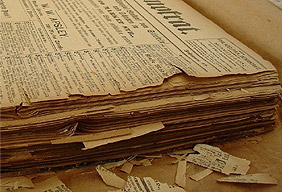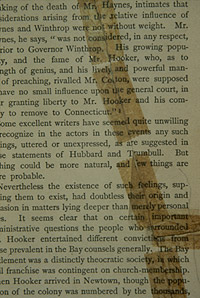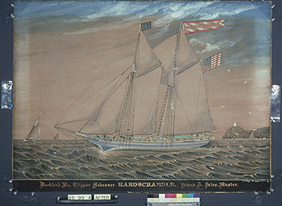
Inherent Vice: Materials
1 Paper |2 Parchment and Vellum |3 Leather |4 Adhesives |5 Colorants |6 Ink and Pencil
Over the course of time, a variety of materials and methods have been used to produce paper-based collections. Generally the primary goal of using new materials and different manufacturing methods was to make a particular process (papermaking, book binding, etc.) faster and easier. Unfortunately, many of these "new and improved" methods and materials were not a step forward in terms of the physical longevity of collections. As you will see, many of them actively contributed to increased deterioration of paper-based collections.
In this section, you will consider the basic materials that make up paper-based collections and the concept of "inherent vice." This refers to deterioration caused by agents present in the materials themselves, as opposed to deterioration caused by external forces. These agents may be inherent in the raw materials, or they may be added as part of the manufacturing process.
1 Paper
Most papers produced from the mid-19th century to the present become brittle in about 25 to 50 years. Surveys done in the 1980s showed that yellowing and brittleness are present in about 25 to 40 percent of research library collections.
|
|
Materials Used to Make Paper
Early paper made from materials such as linen, cotton, and hemp rags was relatively stable and durable. However, there was a chronic shortage of these materials, which became steadily worse as the demand for paper grew. In the early 19th century, the invention of the cotton gin (which separated the cotton fiber from the seed), provided an additional raw material for papermaking. By the middle of the 19th century, papermakers began to look elsewhere for raw material that was more affordable and easier to manipulate.
In the 1840s, a process was developed to use groundwood pulp for paper. Groundwood papers contain more lignin (a naturally occurring organic compound) than is found in fibers such as flax or hemp. Lignin is not only acidic, causing the paper to become weak and brittle, but upon exposure to light it oxidizes, causing the paper to darken.
Changes in Manufacturing
The desire to make paper more efficiently, quickly, and cheaply also contributed to the decline in paper quality over the course of several hundred years.
Sizing makes a paper’s surface more suitable for writing, and can be done either by coating the paper by hand or dipping it into a tub of sizing solution. After about 1650, alum was added to the tub of gelatin sizing to harden it and keep it from spoiling. Alum is extremely acidic and leads to acid hydrolysis of the paper.
In about 1680, a mechanical device for chopping the textile rags to be made into paper. This device, the Hollander beater, along with a rotary chopping mill called the Jordan, resulted in weaker paper with shorter fibers. These mechanized processes also left residual metal particles in the paper. Another damaging process began in the 18th century, when chlorine bleaching was introduced as a method of whitening paper. Unfortunately, the bleaching process formed hydrochloric acid within the sheets, which dramatically shortens the strength of the paper.
In the early 19th century, alum rosin sizing was introduced to speed up the papermaking process. The paper was sized in the vat before the paper sheet was formed by adding rosin to the vat, followed by alum. This combination created sulphuric acid as a byproduct of the reaction between the alum and the rosin, and in-the-vat sizing meant that acids were distributed throughout the paper, rather than just on the surface. Cumulatively, this resulted in more acidic, weaker, and more brittle paper. Alum rosin sizing was widely used by the 1840s, and in the 1870s a cheaper (and even more acidic) form of the sizing was developed.
Permanent/Durable Paper
It is possible to make good quality machine-made papers by using a chemically purified wood pulp, which separates the cellulose fiber from the other elements of the wood. A standard for permanent paper was developed during the 1980s because of demands by interested parties concerned about the brittle book problem. Permanent paper is defined by the National Information Standards Organization (NISO) in ANSI/NISO Z39.48-1992 (R2009), Permanence of Paper for Publications and Documents in Libraries and Archives. The standard defines permanent paper as having a 2% minimum alkaline reserve (to make it more chemically stable), less than 1% lignin, good tear resistance (a measure of durability), and a pH of 7.5 to 10.0.
2 Parchment and Vellum
The invention of parchment is often credited to King Eumenes of Pergamum (an ancient city in Asia Minor) in the second century BC, but writing on animal skins was common for centuries before that. The term parchment sometimes refers to any skin that has been prepared for writing, and sometimes refers specifically to sheepskin. The term vellum refers to calfskin only. Parchment and vellum were originally used for scrolls and other documents. They were also used as pages in books from the second century AD onward, and as bookbinding material.
Until the fourth century AD, skins were treated with salt, flour, and other vegetable products to prepare them for writing; after this, skins were treated with lime water, an alkaline substance. Parchment is generally more alkaline and more stable than leather.
|
|
Characteristic Types of Deterioration
Beginning in the early 19th century, chemicals (such as sulphur compounds) were added to the lime water baths to speed up the process of preparing the skin, but these made the skin weaker. Additional chemicals such as formaldehyde were then added to try to counteract this weakness, but only resulted in stiffer skins with less elasticity. In addition, sulphur compounds remained in the skin after rinsing and were converted into sulphuric acid, which in turn reacted with calcium carbonate to produce gypsum. The presence of gypsum causes parchment to turn a gray color.
Parchment is also subject to photochemical reactions (the result of light exposure) in which hydrogen peroxide forms, causing the parchment to break down and become brittle and fragile (gelatinized). If gelatinized parchment is brought into contact with water, it will disintegrate into loose flakes.
See the entry for Parchment in the AIC Book and Paper Group's Paper Conservation Catalog for a complete overview of parchment identification, manufacture, and deterioration.
3 Leather
Like parchment, leather is made from animal skins. Fundamentally, leather consists of a network of fibers made up of proteins, the most important of which is collagen. There are many different types of leather, and making leather is a complex process, for which different manufacturers have different methods.
|
|
Characteristic Types of Deterioration
Perhaps the most well-known leather damage is red rot, the process in which the leather fibers break down and turn into a red powder. In this process, sulphur dioxide is absorbed from the atmosphere and converted into sulphuric acid through oxidation. The sulphuric acid catalyzes acid hydrolysis, breaks down the molecular chains of the collagen, and weakens the leather.
Internal factors related to the leather manufacturing process also contribute to leather decay. Remnants of sulphur compounds used during the manufacturing process remain even after the leather is washed, and these components convert over time into sulphuric acid. Traces of metals from the rinsing water also remain behind, catalyzing the conversion of sulphur dioxide into sulphuric acid, which leads to acid hydrolysis.
In addition, some vegetable tannins used during the tanning process seem to cause leather to decay more quickly. Finally, marbled decorations applied to book bindings in the 17th and 18th centuries can leave black corroded spots on the binding or damage the grain of the leather.
See the entry Animal Skin/Leather in the AIC Book and Paper Group Book Conservation Catalog for an overview of composition, manufacture, use, and deterioration of leather.
4 Adhesives
The term adhesive refers to a compound that bonds one material to another. Adhesives are encountered in various types of paper-based collections, most commonly in book bindings, scrapbooks, documents that have been repaired, and photo albums. Adhesives can be natural (e.g., wheat starch paste) or synthetic (e.g., polyvinyl acetate); starch adhesives share common properties with cellulose, while synthetic adhesives are very similar to plastics.
Natural adhesives were first made from plant resins about 6,000 years ago. Later, animal, fish, and egg white-based adhesives were used. As modernization of adhesives continued during the 18th and 19th centuries, glues were made from various materials, including natural rubber and milk protein. Synthetic adhesives were developed in the early 20th century. Formulas for modern synthetic adhesives vary greatly, are often proprietary, and can change without notice.
|
|
Characteristic Types of Deterioration
Animal glues, traditionally used in bookbinding, break down over time, becoming discolored, dark, and brittle. They cause staining or simply crumble and fail. Synthetic adhesives react physically with water to produce swelling and chemically to produce structural weakening and acidic byproducts. In addition, evaporation of components within adhesives can cause them to become brittle.
Many adhesives used in collections in the past have not lasted well. Damage often includes discoloration, staining, and even failure of the adhesive, particularly in the cases of rubber cement and self-adhesive tape. While "archival" pressure-sensitive tapes that appear to be more stable than traditional pressure-sensitive tapes have been introduced, some problems have been observed with these tapes also. Natural adhesives such as wheat or rice starch paste are relatively stable and are often used in book and paper conservation.
See the entry for Adhesives in the AIC Book and Paper Group Paper Conservation Catalog, particularly Section 46.3 Materials and Equipment for an overview of the composition, use, and deterioration of many types of adhesives applied to paper-based collections.
5 Colorants
Colorants of various types are encountered in watercolors, pastels, prints, architectural drawings and reproductions, writing and drawing inks, and color photography.
General Characteristics
Colorants are divided into two categories—pigments and dyes. Both are colored substances that are dissolved in some type of liquid (called a vehicle). A pigment is not soluble in the vehicle, but rather is dispersed or suspended in it. A dye, on the other hand, is soluble in the vehicle and colors an object by being absorbed into it, often with the assistance of another chemical called a mordant.
The science of colorants is quite complex. In some cases, a colorant can be either a pigment or a dye, depending on the vehicle used. Many modern pigments are made from soluble dyes by chemically bonding the dyes with a metallic salt (such a pigment is called a "lake"). Pigments and dyes are customarily classified according to their origins, such as organic or inorganic and natural or synthetic (e.g., chemically manufactured).
History
Natural inorganic pigments made from minerals were first used about 60,000 years ago. Natural organic pigments (made from extracts from plant and animal materials) have been used since antiquity for many purposes, including cosmetics and textile dying. The first synthetic pigments were inorganic. After 1800, technology had developed sufficiently to produce these pigments on a large scale. In 1856, the first synthetic organic dye (mauve) was developed from aniline, a chemical extracted from coal tar.
|
|
Characteristic Types of Deterioration
The primary form of colorant deterioration is fading, although some historical pigments also deteriorate upon contact with other substances, such as heat, acidic or alkaline materials, and chemicals. Some inorganic pigments of metallic origin may also cause oxidation and acidic deterioration similar to that caused by iron-gall inks.
Fading is a chemical change in which ultraviolet light reacts with the colorant, or triggers a reaction with oxygen or moisture, causing the colorant to change to a colorless (or less colored) compound.
Natural inorganic pigments were very stable and permanent, but due to the difficulty in manufacturing them, they have been replaced in modern times with synthetic inorganic colors (many of which are also quite permanent). Natural organic pigments were very unstable and subject to light fading. The early synthetic organic colorants (aniline-based), while quite brilliant and intense, were also very unstable. Advances in organic chemistry during the 20th century have resulted in many modern synthetic organic pigments that are much less prone to fading.
Lists of historical pigments, as well as modern pigments that are ASTM (American Society for Testing and Materials) approved for artists' use, can be found in The Artist's Handbook of Materials and Techniques (see Additional Resources). These lists provide rankings for lightfastness in addition to other characteristics. The Watercolors website also provides information on the history and characteristics of pigments.
6 Ink and Pencil
Ink is essentially a liquid in which one of many possible types of pigments or dyes is suspended. Pencils are made from graphite, a form of carbon. In paper-based collections, ink is encountered not just in documents but also in printed items and artworks. Pencil is generally encountered in handwritten documents and drawings.
History
Inks for writing and drawing were probably first made around 2500 BC in Egypt and China. These were made from carbon suspended in water and vegetable gum (hardened sap). Through the centuries, many other inks were developed using berries, plants, and minerals to provide colorants. When synthetic aniline dyes were developed in the mid-19th century, they were soon used in inks. Since that time, a huge variety of ink formulas have been created, most of which are proprietary, and many of which are prone to fading, color changes, and smearing.
Pencil is a stable medium. The process used to make modern pencils was developed and patented in France in 1795. Henry Petroski's The Pencil (see Additional Resources) provides a history of the development of the pencil. Those caring for collections should also be aware of the existence of copying pencils (developed in the late 1870s for use with the letterpress copying process). Markings made with copying pencils can be mistaken for those made with graphite pencils, but in fact the copying pencils contain not just graphite, but also aniline dyes that are water and alcohol soluble.
|
|
Deterioration of Ink
Carbon-based inks—These are the earliest types of writing ink. Good quality early carbon inks do not discolor with age, but can smudge in high humidity. Poor quality carbon inks may turn a brown color over time.
Iron gall ink—This was the predominant type of writing ink for many centuries. It was used as early as the fifth century and was common from the 12th century well into the 20th century. Iron gall ink is made by mixing tannic acid with an iron salt. Both high acidity within the ink (leading to acid hydrolysis of the paper) and oxidation of excess iron compounds present in the ink make it very damaging to the support (usually paper). In extreme cases the ink actually "eats through" the support. See the Ink Corrosion website for more information on iron gall ink.
Colored inks—Colored inks are made using pigments or soluble dyes (see the discussion of colorants in this session). In general, inks made using light-resistant pigments are of better quality. Inks made from soluble dyes (including most of those used in felt-tip markers) are not lightproof and may be water soluble as well.
Traditional printing inks—Traditional inks used to make prints such as intaglio (engraved) prints or lithographs, differ from writing inks in that they are oil-based (more greasy and gelatinous), allowing them to adhere better to the printing surfaces and to perform well with printing equipment. While many of these inks were quite stable, others used fugitive pigments (which fade over time or on exposure to light) and were subject to bleeding. Also, if the ink was poorly manufactured, excess oil sometimes caused staining. Refer to Bamber Gascoigne's How to Identify Prints (see Additional Resources) for an explanation of printing methods.
Laser and inkjet printing—These were introduced on a large scale in the 1980s and have now become ubiquitous. Laser printing uses carbon inks and involves the same process as electrostatic copying (discussed later in this session). Black and white laser printing is quite stable. Most general-use inkjet printers use dye-based inks that are not very lightfast and are often water-soluble. See the discussion of digital prints for more information on inkjet printing.
Fax printing—Thermal transfer technology, used for fax printing and other purposes, became common during the 1980s. Printed documents using this technology tend to be very unstable.






